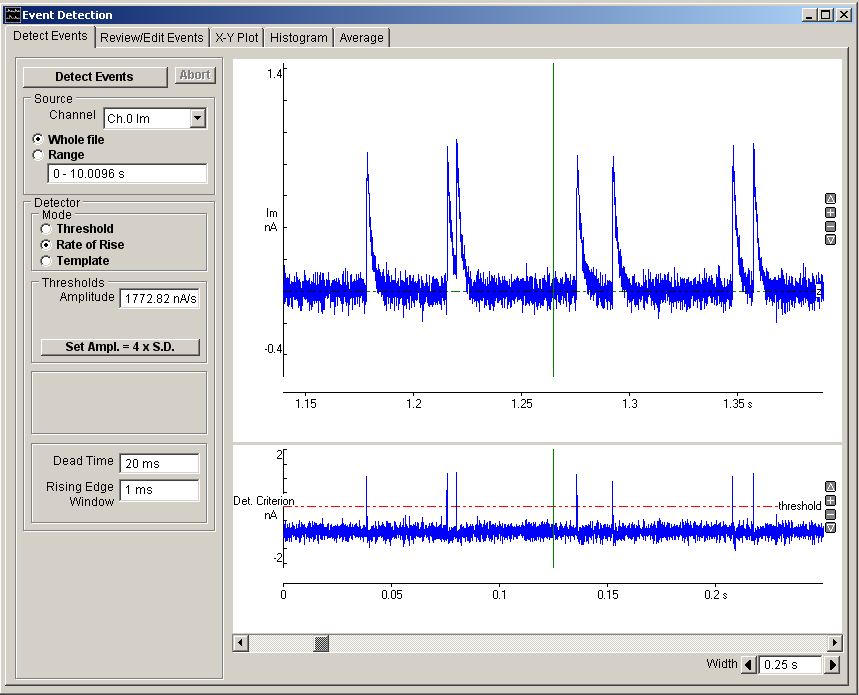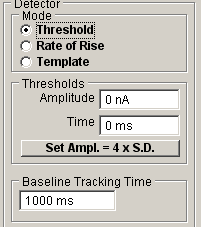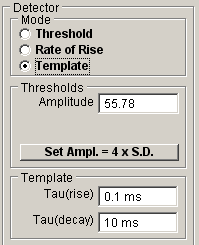Detecting & Analysing Events > Detecting Events
To detect events within a continuous record, select the Detect Events page. The recording to be scanned is displayed in the upper panel and the detection criterion derived from it is displayed in the lower.

Three different types of event detection method are supported:
· Threshold: The amplitude threshold method uses a baseline-tracking amplitude threshold algorithm, the detection criteria being that the signal exceeds the threshold level for more than a predetermined period of time. The signal baseline level is computed from a running average used to automatically adjust the threshold for slow changes in baseline level.
· Rate of rise: The rate of rise method uses a signal detection criterion based upon the signal rate of change computed using a 5-point Savitsky-Golay differentation algorithm.
· Template: The template matching method is an implementation of the optimal template matching algorithm developed by Clements & Bekkers (1997) An exponentially decaying waveform template defined by the equation
is slid point-by point along the digitised signal, its amplitude, A, and offset, C, being adjusted at each step using least squares methods to obtain the best fit. The ratio between best fit template amplitude and residual sum of squares is used as a detection criterion. See Clements & Bekkers (1997) for details of the method.
The rate of rise and amplitude threshold methods are applicable to any shape of signal while the template matching method is specifically designed for decaying exponential signals such as postsynaptic currents or potentials.
To scan a segment of the continuous digitised recording for event:
1. Source: Select the Whole File option to scan the complete file, or select Range and enter a time interval defining the section of the recording to be scanned.
2. Source: If there is more one channel within the recording, select the channel to be scanned for signals, from the Channel list.
3. Mode: Select the event detection method (Amplitude, Rate of rise or Template).
4. Thresholds (Amplitude mode): Set the level which the signal detection criterion has to cross for an event to be detected in the Amplitude box (or adjust the threshold cursor in the Det. Criterion display).Set the period of time which the signal has to remain above the amplitude threshold before detection is accepted in the Time box. Set the period of time over which the baseline tracking average is computed in the BaselineTracking Time box. (The smaller the time period, the faster the tracking rate of the baseline.)
Thresholds (Rate of Rise mode): Set the level which the signal detection criterion has to cross for an event to be detected in the Amplitude box (or adjust the threshold cursor in the Det. Criterion display).
. 
Thresholds (Template mode): Set the level which the signal detection criterion has to cross for an event to be detected in the Amplitude box (or adjust the threshold cursor in the Det. Criterion display). Enter the rising and decaying time constants which define the shape and duration of the template waveform into the Tau(rise) and Tau(decay) boxes. (Suitable values can be obtained by detecting a typical signals using one of the other detection methods, exporting the record to WinEDR and fitting an MEPC curve to it.).
. 
(Note. The Set Amp.=4xS.D. button can be used to set the amplitude threshold to 4x the standard deviation computed from the displayed signal).
5. Dead Time: To avoid repeated detection of the same signal, set the time period before another signal can be detected in the Dead Time box. (Usually set equal to the expected duration of the longest signals being detected.)
6. Rising Edge Window:
7. Click Detect Events to begin the event detection process.